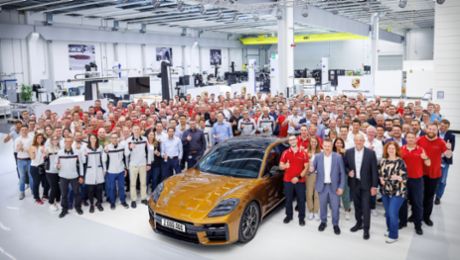On 30 October 2024, Porsche is inviting music and history lovers to the Nikolaikirche for a free concert. An ensemble from the Gewandhaus Orchestra, which Porsche has supported since 2014, will be performing. “Porsche sees itself as a partner to society. An important aspect of our commitment is to preserve culture and make it easily accessible to everyone,” says Gerd Rupp, Chairman of the Management Board of Porsche Leipzig GmbH. “We are therefore delighted to stage this concert and invite the people of Leipzig to experience their organ’s new sound.”
Further festival week highlights include guided organ tours, concerts for children and school classes, as well as organ, orchestra and Bach Choir performances. The musical selections will include works by Johann Sebastian Bach, who was active in the Nikolaikirche during his period as Thomaskantor in Leipzig. Organ music will also accompany the traditional Prayer for Peace on Monday and the Reformation Service.
Car manufacturing meets organ building
Two of the new organ stops will be named after the Porsche Macan and Panamera models, which are produced in Leipzig, a centre for trade fairs and music. “The music in the Nikolaikirche will sound even more multifaceted in the future. With 25 tubular bells, the ‘Macan’ timbre will bring unique frequencies to the space within the church. ‘Panamera’ will represent the brilliant sounds of a steel arrangement in the Nikolaikirche. The ‘Vox Populi’ will allow the ‘Voice of the People’, based on the legacy of the Peaceful Revolution, to resonate far beyond the confines of the church,” says Markus Kaufmann, Cantor at Nikolaikirche.
The work on the new stops, expected to take around one year under the auspices of the Herrmann Eule organ workshop in Bautzen, is already well underway. “For the installation and tuning, we will be taking the organ out of service for several weeks, starting in March. The new stops will be heard for the first time during the festival week in October,” says Kaufmann. “For me, as a car maker, it’s exciting to see how much patience, skill and love of detail is required for working on an organ,” continues Rupp. “Precision and passion are values that also drive us car manufacturers on a daily basis. I really admire the work of the organ builder. A year of meticulous handicraft will be going towards the perfection of a wonderful instrument.”
The Ladegast Eule organ: a successful symbiosis of tradition and state-of-the-art
The organ in the Nikolaikirche was built in 1862 by Friedrich Ladegast, a master organ builder from Weissenfels. When Ladegast built the instrument with its 84 stops on four manuals, it was both his greatest work and the biggest organ in the Kingdom of Saxony. Between 1723 and 1750 it was the principal domain of Johann Sebastian Bach. Between 2000 and 2004, with a donation of 1.8 million euros, Porsche financed an extensive restoration, which had become necessary due to signs of wear. The goal was to preserve the original Ladegast sound, and the restorers were able to conserve two thirds of the original material. Porsche and the Ladegast Eule organ also share a design feature. Because the original Ladegast console no longer existed, the sports car manufacturer’s designers remodelled one using elements of automotive engineering. It is equipped with a reversing camera to observe the altar space and has seat heating and limit indicators with a tachometer look. Plus, like many Porsche models, it is switched on to the left of the keyboard.
“By supporting the restoration of the Ladegast organ in 2004, Porsche was making a clear commitment to its still relatively new production site in Saxony,” says Rupp. In 2002, the newly opened Leipzig plant had started production of its first model, the Porsche Cayenne.
Due to its role in the Peaceful Revolution of 1989, the Nikolaikirche is a historical place of great symbolic value, the appeal of which extends beyond the region. The population’s protests against the leadership of the German Democratic Republic (GDR) started with the Monday Freedom Prayers and ultimately led to the fall of the Berlin Wall and the reunification of Germany. The Nikolaikirche stands for freedom and democracy.




.jpeg/jcr:content/MicrosoftTeams-image%20(4).jpeg)